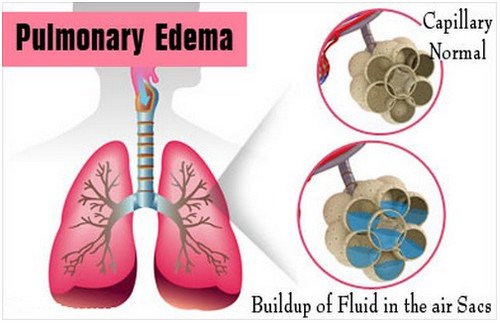The lungs contain alveoli, a number of small, elastic air sacs. As you breathe, the alveoli take in oxygen and release carbon dioxide.
It is the normal exchange of gasses in the body. However, there are instances when instead of air, fluid gets inside the alveoli.
It causes insufficient oxygen in the bloodstream. As fluid gets in the lungs, they become swollen leading to a condition called pulmonary edema.
Please note: Pulmonary edema is accumulation of fluid within the lungs Vs Pleural effusion is accumulation of fluid outside the lungs
The lungs swell and inflamed. The very reason for this is the fluid inside the blood vessels seeps outside as well into the surrounding tissues. (1, 2)
What causes of fluid in lungs (pulmonary edema)?
The causes of pulmonary edema (swelling of the lungs due to presence of fluid) is categorized into two: cardiogenic and non-cardiogenic.
Cardiogenic causes are a result of high pressure in the blood vessels of the lungs, which is associated to poor functioning of the heart.
Examples are
- congestive heart failure
- abnormal heart valves
- heart attack.
On the other hand, the non-cardiogenic pulmonary edema causes are
- acute respiratory distress syndrome (ARDS)
- kidney failure, high altitude pulmonary edema
- brain trauma
- side effect of medication
- pulmonary embolism
- transfusion-related acute lung injury
- pneumonia
- eclampsia
- sepsis (blood infection)
- drug overdose
- exposure to strong chemicals
- near-drowning
- organ failure. (2, 3, 4)

Image 1: A comparison of healthy lungs and lungs filled with fluid.
Picture Source: s-media-cache-ak0.pinimg.com

Photo 2: How lungs look like if they are filled with fluid.
Picture Source: www.medindia.net
Fluid in lungs symptoms
- Shortness of breath
- Difficulty breathing (dyspnea), especially during exertion and when lying flat
- Fatigue
- Rapid breathing (tachypnea)
- Weakness
- Dizziness
- Hypoxia (low level of oxygen in the blood)
- Abnormal lung sounds upon examination using a stethoscope. The doctor can hear crackles or rales, bubbling sound indicating that fluid splashes through the alveoli when breathing.
- Excessive sweating
- Cough with pink frothy sputum
- Restlessness
- Anxiety
- Pale skin
- A feeling of suffocation
- Chest pain
- Weight gain secondary to accumulation of fluid (4, 5, 6)
When you should call out for help?
If you are experiencing a combination of the symptoms mentioned above, especially difficulty or labored breathing, then you have to consult your health care provider right away. Having a fluid in the lungs is a major thing. It can jeopardize your health and life.
The patient requires hospitalization to thoroughly assess and treat the underlying condition. The patient is seen by a team of specialist consisting of the pulmonologist (lung doctor), cardiologist (heart doctor), and internist (internal medicine doctor). (6)
How to diagnose fluid in the lungs?
- Chest x-ray – It is performed to thoroughly inspect the condition of the lungs. It is one of the reliable test to assess the presence of pulmonary edema. This test can accurately detect the fluid in and around the lungs. It is also used to check the size of the heart.
- Physical examination – The doctor will perform a thorough physical examination, paying particular attention to the lungs. A stethoscope is used to listen to the sounds produced in the lungs. The heart will also be checked for abnormal rhythms.
- Blood works – A complete blood count is ordered to determine the level of oxygen in the blood. Specialized blood test will be performed to check for the level of electrolytes, liver and kidney functions, blood counts and blood markers. The plasma B-type natriuretic peptide (BNP) is checked. It is a type of protein marker, which typically rises in the blood if the chambers of the hearts are stretched.
- CT scan of the chest – A CT scan can help detect the condition of the lungs and the surrounding structures. If it is elevated, then it could indicate that the patient is possibly suffering from cardiac pulmonary edema.
- Electrocardiogram – It is ordered to detect the rhythm of the heart and to rule out any rhythm disturbances. It uses ultrasound images, which help identify abnormalities in the valve, the efficiency of the heart to pump blood, and the thickness of the heart muscles. (7, 8, 9, 10)
How to treat pulmonary edema?
- Improve the oxygen level in the blood – It is a must to improve the level of oxygen in the patient’s blood. Oxygen is introduced to the body via the face mask or prongs (small plastic tubes in the nose). If the patient is on a breathing machine, a breathing tube is placed into the trachea.
- IV drugs – If the fluid in the lungs is cardiac-related, the doctor will prescribe medicines that will help get rid of the fluid in the lungs. A drug will also be prescribed to control the patient’s blood pressure. The drug is usually a combination of diuretics and medicines for heart failure. If the fluid in the lungs is of non-cardiac cause such as severe infection, the doctor will prescribe the proper antibiotics along with supportive measures. A morphine can be given to the patient to ease anxiety and improve the patient’s breathing.
- Breathing machines – If the patient has respiratory failure, a breathing machine is used to force air into the lungs. Examples are CPAP and BiPAP. If the patient can’t breathe on his own, he needs to be intubated. A ventilator is usually needed. (8, 9, 10)
What are the complications?
Fluid in the lungs can dramatically affect the oxygenation of blood in the lungs. The oxygen content of the blood is diminished, which could affect the oxygen level in various parts of the body, especially the brain. (3)
What you should do to prevent fluid in the lungs?
- You should maintain a healthy lifestyle to avoid and control diseases like diabetes, hypertension, heart-related diseases, and heart attack.
- You should be cautious when taking medications. See to it that you follow the right dosage to avoid drug overdose.
- Make it a habit to visit your primary care physician regularly.
About 2% of the population of the United States suffer from fluid in the lungs. To decrease the risk of fluid in the lungs, education is the primary key. Hundreds of thousands of hospital admission is associated with pulmonary edema because of fluid in the lungs.
To detect the problem at an early stage or better yet prevent the onset of the problem, you should consult your doctor religiously. (2, 3, 4)
References:
- www.medicinenet.com
- www.healthline.com
- www.mayoclinic.org
- www.webmd.com
- www.emedicinehealth.com
- www.medicalnewstoday.com
- https://medlineplus.gov
- www.healthhype.com
- https://en.wikipedia.org
- Chest Medicine: Essentials of Pulmonary and Critical Care Medicine edited by Ronald B. George



